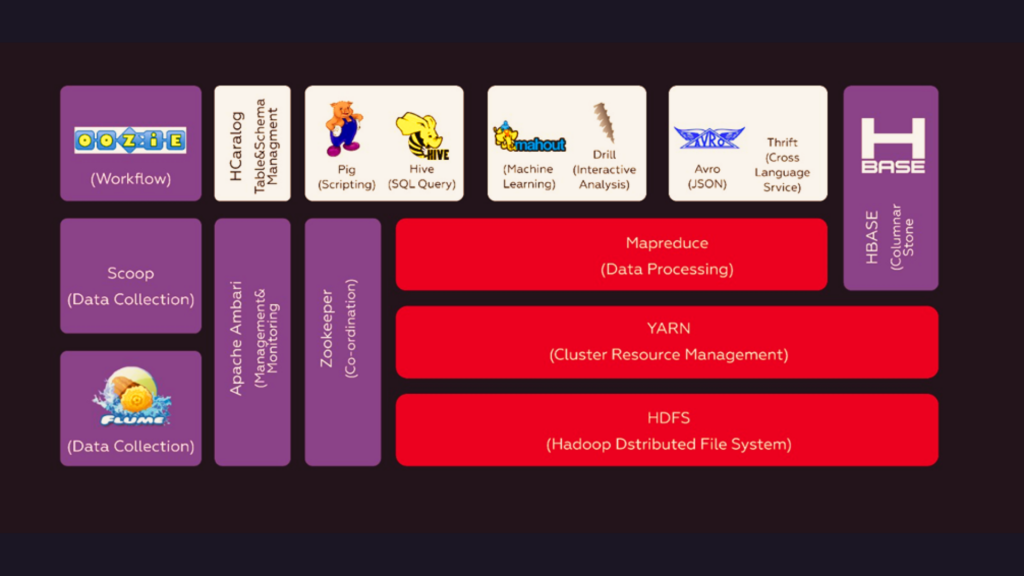
Understanding Apache Hadoop Ecosystem
“The Apache Hadoop software library is a framework that allows for the distributed processing of large data sets across clusters of computers using simple programming models. It is designed to scale up from single servers to thousands of machines, each offering local computation and storage. Rather than rely on hardware to deliver high-availability, the library itself is designed to detect and handle failures at the application layer, so delivering a highly-available service on top of a cluster of computers, each of which may be prone to failures.”
The project includes these modules:
- Hadoop Common: The common utilities that support the other Hadoop modules.
- Hadoop Distributed File System (HDFS™): A distributed file system that provides high-throughput access to application data.
- Hadoop YARN: A framework for job scheduling and cluster resource management.
- Hadoop MapReduce: A YARN-based system for parallel processing of large data sets.
YARN (Distributed Resource Management): Part of the core Hadoop project, YARN is the architectural center of Hadoop that allows multiple data processing engines such as interactive SQL, real-time streaming, data science and batch processing to handle data stored in a single platform, unlocking an entirely new approach to analytics. YARN is the foundation of the new generation of Hadoop and is enabling organizations everywhere to realize a modern data architecture.
Spark (Distributed Programming): Apache Spark™ is a fast and general engine for large-scale data processing. Spark provides a simple and expressive programming model that supports a wide range of applications, including ETL, machine learning, stream processing, and graph computation.
Tez (Distributed Programming): Apache™ Tez is an extensible framework for building high performance batch and interactive data processing applications, coordinated by YARN in Apache Hadoop. Tez improves the MapReduce paradigm by dramatically improving its speed, while maintaining MapReduce’s ability to scale to petabytes of data. Important Hadoop ecosystem projects like Apache Hive and Apache Pig use Apache Tez, as do a growing number of third party data access applications developed for the broader Hadoop ecosystem.
Hive (SQL-On-Hadoop): The Apache Hive ™ data warehouse software facilitates reading, writing, and managing large datasets residing in distributed storage using SQL. Structure can be projected onto data already in storage. A command line tool and JDBC driver are provided to connect users to Hive.
Hbase (Column Data Model NoSQL): Apache HBase™ is the Hadoop database, a distributed, scalable, big data store.
Cassandra (Column Data Model NoSQL): The Apache Cassandra database is the right choice when you need scalability and high availability without compromising performance. Linear scalability and proven fault-tolerance on commodity hardware or cloud infrastructure make it the perfect platform for mission-critical data.Cassandra’s support for replicating across multiple datacenters is best-in-class, providing lower latency for your users and the peace of mind of knowing that you can survive regional outages.
MongoDB (Document Data Model NoSQL): MongoDB is a document database with the scalability and flexibility that you want with the querying and indexing that you need. MongoDB stores data in flexible, JSON-like documents.
Redis (Key-Value Data Model NoSQL): Redis is an open source (BSD licensed), in-memory data structure store, used as a database, cache and message broker. It supports data structures such as strings, hashes, lists, sets, sorted sets with range queries, bitmaps, hyperloglogs and geospatial indexes with radius queries. Redis has built-in replication, Lua scripting, LRU eviction, transactions and different levels of on-disk persistence, and provides high availability via Redis Sentinel and automatic partitioning with Redis Cluster.
Flume (Data Ingestion): Apache Flume is a distributed, reliable, and available service for efficiently collecting, aggregating, and moving large amounts of log data. It has a simple and flexible architecture based on streaming data flows. It is robust and fault tolerant with tunable reliability mechanisms and many failover and recovery mechanisms. It uses a simple extensible data model that allows for online analytic application.
Sqoop (Data Ingestion): Apache Sqoop™ is a tool designed for efficiently transferring bulk data between Apache Hadoop and structured datastores such as relational databases.
Kafka (Data Ingestion): Kafka™ is used for building real-time data pipelines and streaming apps. It is horizontally scalable, fault-tolerant, wicked fast, and runs in production in thousands of companies.
Thrift (Service Programming): The Apache Thrift software framework, for scalable cross-language services development, combines a software stack with a code generation engine to build services that work efficiently and seamlessly between C++, Java, Python, PHP, Ruby, Erlang, Perl, Haskell, C#, Cocoa, JavaScript, Node.js, Smalltalk, OCaml and Delphi and other languages.
ZooKeeper (Service Programming): A high-performance coordination service for distributed applications.
Mahout (Machine Learning): The Apache Mahout™ project’s goal is to build an environment for quickly creating scalable performant machine learning applications.
Oozie (Scheduling): Oozie is a workflow scheduler system to manage Apache Hadoop jobs.


